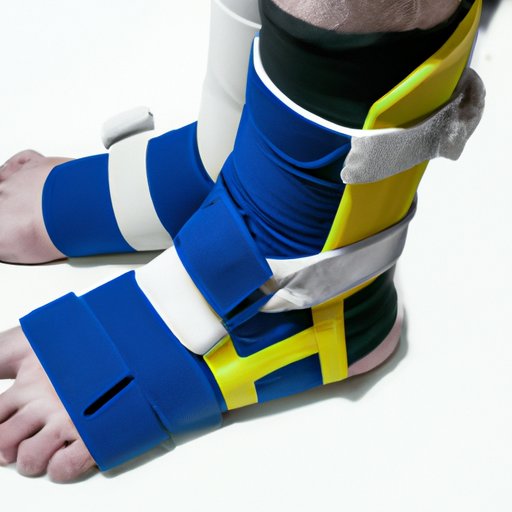
Introduction
If you have ever experienced a broken ankle, you know how difficult it is to bear weight on it. Bearing weight on a broken ankle is a common problem that many people face. Understanding how and when to bear weight on a broken ankle is crucial for a quick and safe recovery.
In this article, we will discuss the dos and don’ts of bearing weight on a broken ankle. We will also cover how to manage pain, tips for a safe recovery, and techniques for staying mobile while healing.
What You Need to Know: Bearing Weight on a Broken Ankle
Broken ankles are a common injury that occurs when the ankle joint is subjected to excessive force. An ankle fracture can range from a minor injury to a severe break that requires surgery. When it comes to bearing weight on a broken ankle, the severity of the fracture is a crucial factor.
The different types of ankle fractures can impact weight-bearing. A stable fracture means that the bones are still aligned, while an unstable fracture indicates that the bones have shifted out of place. In either case, the doctor will determine whether or not the patient can bear weight on the affected ankle.
The diagnosis and treatment options for broken ankles may vary depending on the severity of the injury. A doctor may take an X-ray or image the ankle to confirm the diagnosis. Treatment options can include rest, immobilization, pain relief, and, in some cases, surgery.
The Dos and Don’ts of Weight-Bearing on a Broken Ankle
When it comes to bearing weight on a broken ankle, there are clear dos and don’ts. It is essential to follow these guidelines for a safe recovery.
Dos:
- Follow the doctor’s orders for weight-bearing restrictions
- Use supportive devices, such as crutches, as instructed by the doctor
- Take proper care of the injured ankle to prevent further injuries
- Start physical therapy or rehabilitation as soon as advised
Don’ts:
- Do not bear weight on the injured ankle before the doctor advises to do so
- Do not ignore warning signs, such as swelling, pain, and instability
- Do not rush the healing process; it takes time
- Do not perform any physical activities that put excessive pressure on the broken ankle
Using supportive devices is crucial when bearing weight on a broken ankle. Crutches, walkers, or braces can provide the necessary support needed to move around safely.
Managing Pain: How Soon Can You Bear Weight on a Broken Ankle?
Pain management and timing are critical when it comes to bearing weight on a broken ankle. Pain can impact the healing process, so managing it efficiently is essential. It is also important to consult with a doctor for pain management options.
Taking pain medication as prescribed by a doctor can help reduce pain during the healing process. Appropriate pain management can make it possible to start bearing weight on a broken ankle sooner. It is essential to keep in mind that bearing weight too soon may lead to further injury and an extended healing process.
Road to Recovery: Tips for Safely Bearing Weight on a Broken Ankle
Recovering from a broken ankle requires time, effort, and patience. To ensure a safe and quick recovery, it is essential to follow the right tips and advice. Here are some tips for a successful recovery:
- Start exercises and physical therapy as soon as advised by the doctor
- Understand the importance of balance and stability when recovering from a broken ankle
- Elevate the ankle to reduce swelling and pain
- Eat a balanced diet to help promote faster healing
- Stay positive and avoid excessive anxiety or worry about the healing process
- Wear properly fitted and supportive shoes
Breaking it Down: Understanding the Healing Process of a Broken Ankle and Weight-Bearing
Understanding the biology behind bone healing and how it relates to weight-bearing is vital for a successful recovery. Bones have the ability to regenerate and repair themselves, but the healing process can take time.
When bearing weight on a broken ankle, it is essential to avoid activities that put undue pressure on the ankle, as this can delay the healing process. Stability and balance are critical when re-learning how to walk after a broken ankle.
Injury Management: How to Stay Mobile While Healing a Broken Ankle
Staying mobile while healing a broken ankle can be a challenging task. However, being creative with mobility options can help. It is crucial to consult with a doctor before attempting any physical activities that require weight-bearing.
Relying on mobility aids such as crutches, canes, knee scooters, and walkers can provide the necessary support to move around safely during the healing process. It is important to avoid laziness and compounding injuries during this time, as they can lead to further delays in the healing process.
Conclusion
Bearing weight on a broken ankle is not easy, but with the right care and management, you can achieve a successful and quick recovery. Remember to follow the dos and don’ts, manage pain properly, and practice patience while healing. Taking care of your physical and mental health during the healing process is equally vital.
If you experience any complications throughout the healing process, always seek professional medical help.




